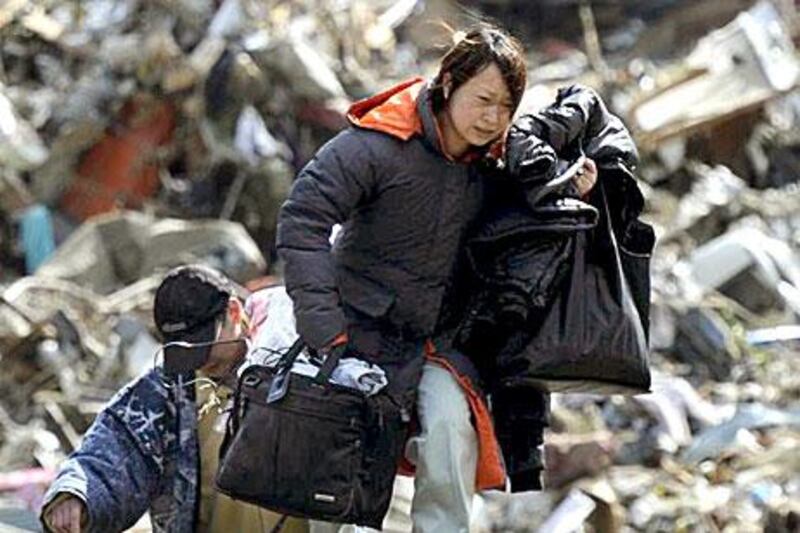SENDAI, Japan // Kilometres from the ocean's edge, weary, mud-spattered survivors wandered streets strewn with fallen trees, crumpled cars, even small aeroplanes. Relics of lives now destroyed were everywhere - half a piano, a textbook, a soiled red sleeping bag.
Yesterday, a day after a massive tsunami tore through Sendai, residents surveyed the devastation that laid waste to whole sections of the northern port of one million people, more than 100km from the epicentre of the 8.9-magnitude earthquake that set off one of the greatest disasters in Japan's history.
Rescue workers plied boats through murky waters around flooded structures, nosing their way through a sea of detritus, while smoke from at least one large fire billowed in the distance. Power and phone reception remained cut as the city continued to be jolted by powerful aftershocks.
A still unknown number of people perished. Police said they found 200 to 300 bodies washed up on nearby beaches, but authorities were still assessing the extent of the devastation in the city and along the nearby coast.
Rail operators lost contact with four trains running on coastal lines on Friday and still had not found them by yesterday afternoon, Kyodo News agency reported. East Japan Railway said it did not know how many people were aboard.
The country's official death toll stood at 574 but local media said at least 1,300 might have died.
Prime Minister Naoto Kan said 50,000 troops would join rescue and recovery efforts, and rescuers still had not reached some of the hardest-hit areas by late yesterday, some 30 hours after the earthquake.
Hundreds of people lined up outside the few still-operating supermarkets in Sendai, stocking up on drinks and instant noodles, knowing it would be a long time before life returns to anything like normal. Some recalled how they cheated death as the massive waves swept some 10 kilometres inland.
A convenience store five kilometres from the shore was open for business, though there was no power and the floors were thick with grime.
"The flood came in from behind the store and swept around both sides," said Wakio Fushima, a shop owner. "Cars were flowing right by."
Many Sendai residents spent the night outdoors, or wandering debris-strewn streets, unable to return to homes damaged or destroyed by the earthquake or tsunami. Those who did find a place to rest for the night awoke to scenes of utter devastation.
The city's Wakabayashi district, which runs directly up to the sea, was a swampy wasteland, with murky, waist-high water. Most houses were flattened, as if a giant bulldozer had swept through.
Satako Yusawa, 69, said she has felt many earthquakes but never anything like what hit Friday afternoon.
"I was having tea at a friend's house when the earthquake hit. We were desperately trying to hold the furniture up, but the shaking was so fierce that we just panicked," she said.
She said her son had just borrowed a large amount of money to build a house, and the family had moved in on February 11. Luckily, he was out of town when the earthquake and tsunami hit, but yesterday they couldn't find the house, or even where it used to stand.
Ms Yusawa broke into tears as she looked out over the devastation. "This is life," she said.
At an electronics story in the city, workers gave away batteries, flashlights and mobile phone chargers. Several dozen people waited patiently outside.
From a distance, the store appeared to have survived the devastation intact. But a closer look revealed several smashed windows and slightly buckled walls.
Inside was chaos. The ceiling of the second floor had collapsed, and large TVs, air conditioners and other products lay smashed and strewn about the aisles.
The contents of the entire building were soaked by automatic sprinklers triggered by the earthquake.
"Things were shaking so much we couldn't stand up," said Hiroyuki Kamada, who was working in the store when the first earthquake hit. "After three or four minutes it lessened a bit and we dashed outside."
The tsunami directly hit the city's dock area and then barrelled down a long approach road, carrying giant metal shipping containers about two kilometres inland and smashing buildings along the way.
Hundreds of cars and trucks were strewn throughout the area - on top of buildings, wedged into stairwells, standing on their noses or leaning against each other as if in prayer.
Most ships in port managed to escape to sea before the tsunami hit, but a large Korean ship was swept onto the dock.
Most buildings out of range of the tsunami appeared to have survived the earthquake without much damage, though some older wooden structures were toppled. Paved roads had buckled in some places.
Mobile phone saleswoman Naomi Ishizawa, 24, was working when the earthquake hit in mid-afternoon. She said it took until nightfall to reach her house just outside Sendai and check on her parents, who were both OK. Their home was still standing, but the walls of a bedroom and bathroom had collapsed and debris was strewn throughout.
And yet, she was lucky. The tsunami's inland march stopped just short of her residence; other houses in her neighborhood were totally destroyed.
Like many people throughout Japan's northeast, she had not heard from others in her family and was worried.
"My uncle and his family live in an area near the shore where there were a lot of deaths," Ishizawa said. "We can't reach them."





